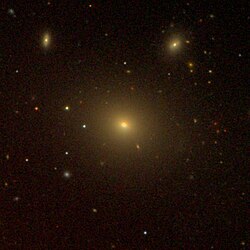| NGC 4213 | |
|---|---|
 SDSS image of NGC 4213 | |
| Observation data (J2000 epoch) | |
| Constellation | Coma Berenices |
| Right ascension | 12h 15m 37.5s [1] |
| Declination | 23° 58′ 55″ [1] |
| Redshift | 0.022349 [1] |
| Heliocentric radial velocity | 6700 km/s [1] |
| Distance | 344 Mly (105.5 Mpc) [1] |
| Group or cluster | NGC 4213 Group |
| Apparent magnitude (V) | 13.48 [1] |
| Absolute magnitude (B) | -22.94 [1] |
| Characteristics | |
| Type | E [1] |
| Size | ~195,700 ly (60.00 kpc) (estimated) [1] |
| Apparent size (V) | 1.7′ × 1.7′ [1] |
| Other designations | |
| UGC 07276, CGCG 128-065, MCG +04-29-054, PGC 039223 [1] | |
NGC 4213 is a elliptical galaxy located 344 million light-years away [2] in the constellation Coma Berenices. It was discovered on April 10, 1785, by astronomer William Herschel. [3] NGC 4213 is a member of the NGC 4213 Group, [4] [5] [6] which is part of the Coma Supercluster. [4] [5] Other members of the group are IC 772, IC 3075, IC 3089, 2MASX J12140497+2404021, and 2MFGC 9641. [6]
Contents
NGC 4213 has a supermassive black hole with an estimated mass of 9.7 × 108 M☉. [7]